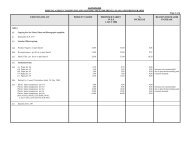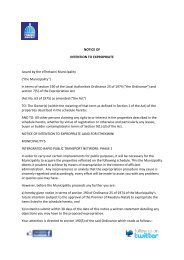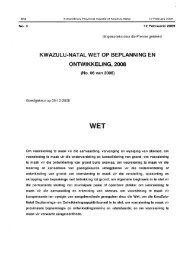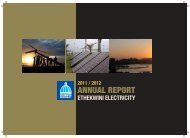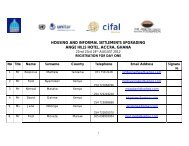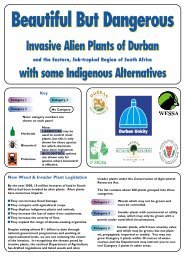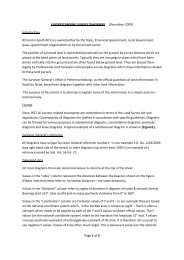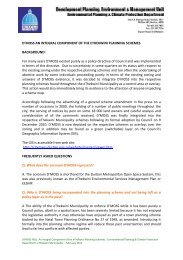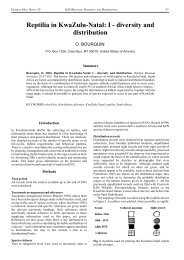Mullin, S. K., Taylor, P. J. & Pillay, N. 2004. Skull size and ... - Durban
Mullin, S. K., Taylor, P. J. & Pillay, N. 2004. Skull size and ... - Durban
Mullin, S. K., Taylor, P. J. & Pillay, N. 2004. Skull size and ... - Durban
Create successful ePaper yourself
Turn your PDF publications into a flip-book with our unique Google optimized e-Paper software.
MULLIN_08 13/08/04 12:45 Page 12<br />
<strong>Mullin</strong> S. K. et al.<br />
west African material on the second axis, the former<br />
comprising OTUs from Kenya, Ethiopia, Burundi,<br />
Rw<strong>and</strong>a, Ug<strong>and</strong>a <strong>and</strong> the eastern part of the DRC<br />
(representing D. incomtus). The group containing<br />
west (D. rufulus) <strong>and</strong> central African (D. incomtus)<br />
material appeared to adhere loosely to a geographic<br />
pattern, although there was no clear separation<br />
between groups. This second group comprised<br />
material from Cameroon, Congo, the DRC, west<br />
Africa (from Senegal to eastern Nigeria), Tanzania,<br />
Malawi, Mozambique <strong>and</strong> Zambia with the exception<br />
of one of the Mozambique OTUs (84-Vila<br />
Coutinho), which was more similar to the east African<br />
material. Material from central Africa (Cameroon,<br />
Congo <strong>and</strong> the DRC) <strong>and</strong> Zambia both overlapped<br />
with west African OTUs but did not overlap<br />
with each other.<br />
With respect to the dorsal skull shape, most of the<br />
OTUs overlapped extensively showing that they<br />
had very similar skull shapes (Fig. 3). Nineteen of<br />
the 26 affine <strong>and</strong> non-affine components were<br />
statistically significant (p < 0.01), with 91.60%<br />
unexplained. Specimens from the Limpopo <strong>and</strong><br />
Mpumalanga Provinces, the Okavango Delta,<br />
D. i. capensis, D. montanus, D. foxi <strong>and</strong> D. i. griseifrons<br />
were distinct. The first axis, explaining 15.98%<br />
of the variation, suggested a possible divergence<br />
within west African D. rufulus, material from<br />
Ivory Coast, Guinea <strong>and</strong> Liberia forming one subgroup<br />
<strong>and</strong> material from Nigeria, Togo <strong>and</strong> Benin<br />
forming another. The east African material was embedded<br />
within this west African group, as was mate-<br />
12<br />
P R O O F<br />
rial from Angola, central Africa, Zambia, Malawi,<br />
Mozambique, Tanzania, Zimbabwe <strong>and</strong> the<br />
KwaZulu-Natal Province of South Africa. With<br />
the exception of one OTU (105-Vryheid), specimens<br />
from the KwaZulu-Natal <strong>and</strong> Limpopo/Mpumalanga<br />
Provinces (all representing D. i. incomtus) were separate<br />
from each other on the second axis. The Zimbabwe<br />
OTUs formed a separate group from both<br />
of the South African D. i. incomtus populations<br />
(KwaZulu-Natal <strong>and</strong> Limpopo/Mpumalanga<br />
Provinces) <strong>and</strong> the Zambian group. Given the<br />
level of overlap seen in the CVA scatterplot, it<br />
was difficult to determine which specimens the<br />
thin-plate splines (depicted along the first <strong>and</strong><br />
second axes) represented.<br />
The ventral view of the skull (Figure 4) was more<br />
important in distinguishing groups than the dorsal<br />
view, <strong>and</strong> appeared to provide in some instances<br />
similar, or clearer, results to the traditional data.<br />
Twenty-eight of the 36 affine <strong>and</strong> non-affine<br />
components were statistically significant (p < 0.01),<br />
with 93.46% unexplained. Both D. i. capensis<br />
<strong>and</strong> west African material were distinct on the<br />
first axis, while there were no clear groups on the<br />
second axis. A clear separation between these three<br />
groups was seen using traditional measurements<br />
<strong>and</strong> dorsal skull coordinates. Dasymys i. griseifrons<br />
<strong>and</strong> D. foxi did not adhere to geographic patterns<br />
by grouping with either east or west African<br />
material respectively, <strong>and</strong> instead were more similar<br />
to OTUs representing the KwaZulu-Natal<br />
Province <strong>and</strong> Zambia. The second Ethiopian<br />
OTU (30-Jimma) was embedded within the East<br />
African group. Although the Mozambique OTU<br />
(84-Vila Coutinho) that was more similar to<br />
East African material in Figure 2 fell within the<br />
D. rufulus group in Figure 4, two different OTUs<br />
from Mozambique (83-Furnacungo, 86-Beira)<br />
were found within the East African group.<br />
East, central <strong>and</strong> west African material (including<br />
OTUs from Zambia, Malawi <strong>and</strong> Mozambique)<br />
formed more separate groups than seen previously.<br />
The DRC OTUs were again divided between<br />
east <strong>and</strong> west African material (as was seen using<br />
traditional measurements). A separation was also<br />
seen within D. i. incomtus between OTUs from the<br />
KwaZulu-Natal <strong>and</strong> the Limpopo/Mpumalanga<br />
Provinces. Material from Zimbabwe was similar to<br />
materials from both the Limpopo/Mpumalanga<br />
<strong>and</strong> KwaZulu-Natal Provinces. Zimbabwean<br />
OTUs were also similar to individuals from<br />
Zambia, Malawi (Zomba <strong>and</strong> Mulanje Plateau)<br />
<strong>and</strong> Mozambique (Zambue).<br />
The thin-plate splines along the canonical variate<br />
axes for the ventral data (Figure 4) showed that<br />
the west African material had a shorter distance<br />
between the anterior tip of the skull <strong>and</strong> the anterior<br />
tip of the palatal foramen, a longer palatal<br />
foramen, wider nasals, longer sphenopalatine,<br />
larger foramen magnum width, wider toothrow,<br />
larger M1 <strong>and</strong> a wider tympanic bulla, as seen on<br />
the first axis. On the second axis, East African<br />
MAMMALIA • 2004 • 68 (2)


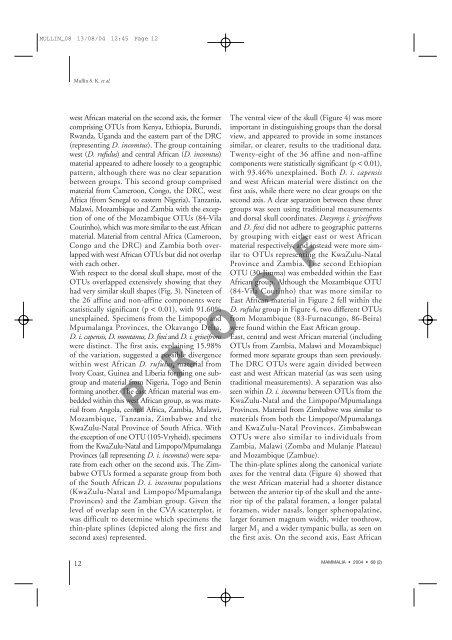
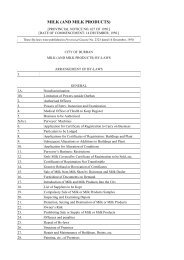
![INK Environmental Sustainability Booklet [19 MB] - Durban](https://img.yumpu.com/22025104/1/190x136/ink-environmental-sustainability-booklet-19-mb-durban.jpg?quality=85)

